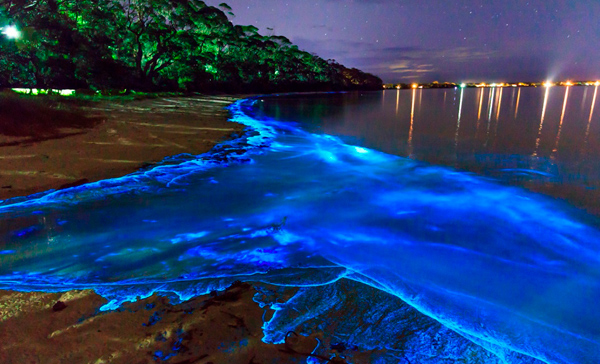
Title: The Fascinating World of Bioluminescence
Bioluminescence, the natural phenomenon of organisms producing light, illuminates the depths of our oceans, forests, and even our own curiosity. This captivating display of nature’s creativity serves both as a survival strategy and a source of wonder for scientists and enthusiasts alike. Here’s an exploration into the fascinating world of bioluminescence:
1. What is Bioluminescence? Bioluminescence is the emission of light by living organisms. It occurs due to a chemical reaction between a light-emitting molecule called luciferin, oxygen, and an enzyme called luciferase. This reaction produces a glow that can range from faint to intensely bright, depending on the species.
2. Diversity of Bioluminescent Organisms: Bioluminescence is not limited to a single type of organism; it can be found across various biological kingdoms, including bacteria, fungi, insects, fish, and marine creatures. Some of the most well-known examples include fireflies, certain species of jellyfish, and deep-sea creatures.
3. Adaptations and Functions: Bioluminescence serves a variety of functions in different organisms. For many deep-sea creatures, it is a way to communicate, find food, or attract mates in the darkness of the ocean depths. Fireflies use bioluminescence to attract potential mates through a rhythmic flashing pattern unique to each species.
4. Mysteries of the Deep Sea: The deep sea is home to some of the most captivating bioluminescent displays. Inhabitants of the abyssal zone, where sunlight cannot penetrate, have evolved elaborate methods of generating light to navigate, find prey, and avoid predators. Some species even have specialized light-producing organs called photophores.
5. Bioluminescence in Nature’s Spectacles: Certain natural phenomena are made even more awe-inspiring by bioluminescence. “Sea sparkle,” for example, occurs when bioluminescent plankton are disturbed by the motion of waves, creating a sparkling, ethereal effect along coastlines.
6. Scientific Applications: Bioluminescence has practical applications in scientific research. It is utilized as a tool in fields like molecular biology and genetics, where the luciferase enzyme is used as a reporter to track gene expression and biochemical reactions in living cells.
7. Environmental Concerns: As human activity affects natural ecosystems, concerns about the impact on bioluminescent organisms have arisen. Light pollution from coastal development can disrupt the natural behavior of bioluminescent creatures that rely on darkness for survival and reproduction.
8. Inspiring Art and Innovation: Bioluminescence has inspired artists, writers, and innovators. Its enchanting glow has been recreated in various art forms, and scientists have drawn inspiration from bioluminescent organisms to develop technologies such as glow-in-the-dark plants for sustainable lighting.
9. Unlocking Nature’s Secrets: Despite significant scientific progress, bioluminescence continues to hold mysteries. Researchers are still discovering new species and unraveling the complexities of the biochemical processes behind this phenomenon.
From the mesmerizing glow of fireflies on a warm summer night to the ethereal beauty of deep-sea creatures illuminating the abyss, bioluminescence offers a glimpse into the intricate interplay between life, light, and the mysteries of our natural world. It reminds us of the endless wonders that nature has yet to reveal.




0 Comments